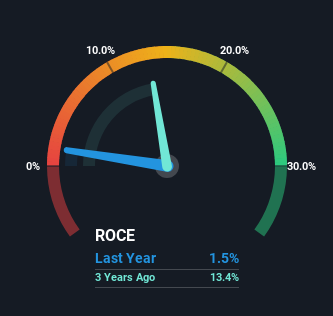- India
- /
- Professional Services
- /
- NSEI:ALANKIT
Alankit (NSE:ALANKIT) Might Be Having Difficulty Using Its Capital Effectively
To find a multi-bagger stock, what are the underlying trends we should look for in a business? Ideally, a business will show two trends; firstly a growing return on capital employed (ROCE) and secondly, an increasing amount of capital employed. Put simply, these types of businesses are compounding machines, meaning they are continually reinvesting their earnings at ever-higher rates of return. Having said that, from a first glance at Alankit (NSE:ALANKIT) we aren't jumping out of our chairs at how returns are trending, but let's have a deeper look.
What Is Return On Capital Employed (ROCE)?
For those that aren't sure what ROCE is, it measures the amount of pre-tax profits a company can generate from the capital employed in its business. The formula for this calculation on Alankit is:
Return on Capital Employed = Earnings Before Interest and Tax (EBIT) ÷ (Total Assets - Current Liabilities)
0.015 = ₹30m ÷ (₹3.0b - ₹1.0b) (Based on the trailing twelve months to March 2023).
So, Alankit has an ROCE of 1.5%. In absolute terms, that's a low return and it also under-performs the Professional Services industry average of 12%.
View our latest analysis for Alankit

While the past is not representative of the future, it can be helpful to know how a company has performed historically, which is why we have this chart above. If you're interested in investigating Alankit's past further, check out this free graph of past earnings, revenue and cash flow.
SWOT Analysis for Alankit
- Debt is well covered by .
- Dividend is in the top 25% of dividend payers in the market.
- Interest payments on debt are not well covered.
- Current share price is above our estimate of fair value.
- Shareholders have been diluted in the past year.
- Has sufficient cash runway for more than 3 years based on current free cash flows.
- Lack of analyst coverage makes it difficult to determine ALANKIT's earnings prospects.
- Debt is not well covered by operating cash flow.
- Paying a dividend but company is unprofitable.
The Trend Of ROCE
The trend of ROCE doesn't look fantastic because it's fallen from 26% five years ago, while the business's capital employed increased by 130%. Usually this isn't ideal, but given Alankit conducted a capital raising before their most recent earnings announcement, that would've likely contributed, at least partially, to the increased capital employed figure. It's unlikely that all of the funds raised have been put to work yet, so as a consequence Alankit might not have received a full period of earnings contribution from it.
The Bottom Line On Alankit's ROCE
In summary, Alankit is reinvesting funds back into the business for growth but unfortunately it looks like sales haven't increased much just yet. And investors appear hesitant that the trends will pick up because the stock has fallen 57% in the last five years. All in all, the inherent trends aren't typical of multi-baggers, so if that's what you're after, we think you might have more luck elsewhere.
Alankit does come with some risks though, we found 5 warning signs in our investment analysis, and 4 of those are a bit concerning...
For those who like to invest in solid companies, check out this free list of companies with solid balance sheets and high returns on equity.
New: Manage All Your Stock Portfolios in One Place
We've created the ultimate portfolio companion for stock investors, and it's free.
• Connect an unlimited number of Portfolios and see your total in one currency
• Be alerted to new Warning Signs or Risks via email or mobile
• Track the Fair Value of your stocks
Have feedback on this article? Concerned about the content? Get in touch with us directly. Alternatively, email editorial-team (at) simplywallst.com.
This article by Simply Wall St is general in nature. We provide commentary based on historical data and analyst forecasts only using an unbiased methodology and our articles are not intended to be financial advice. It does not constitute a recommendation to buy or sell any stock, and does not take account of your objectives, or your financial situation. We aim to bring you long-term focused analysis driven by fundamental data. Note that our analysis may not factor in the latest price-sensitive company announcements or qualitative material. Simply Wall St has no position in any stocks mentioned.
About NSEI:ALANKIT
Flawless balance sheet and good value.
Market Insights
Community Narratives




